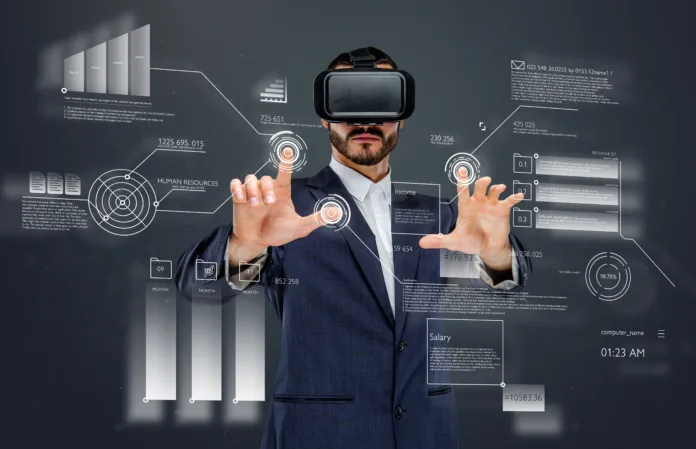
In recent years, Metaverse and Virtual Reality have rapidly evolved from futuristic concepts to practical business tools. With the rise of immersive digital platforms and interactive 3D environments, companies are finding innovative ways to connect with consumers, train employees, and develop products. As the digital economy accelerates, the metaverse and VR technologies are unlocking unprecedented opportunities for businesses to enter and thrive in the 3D web.
These advancements represent more than just trends—they signify a paradigm shift in how brands interact, market, and operate in virtual environments. The fusion of virtual reality and the metaverse offers a powerful toolkit for enhancing engagement, streamlining operations, and creating personalized customer experiences.
What Is the Metaverse?
The metaverse is a collective virtual space created by the convergence of physical and digital realities. It is an expansive, immersive environment where users can interact with one another, digital assets, and virtual surroundings in real time. Often built on blockchain and extended reality (XR) technologies, the metaverse is accessible via VR headsets, augmented reality glasses, or traditional devices like PCs and smartphones.
Unlike standalone virtual environments, the metaverse is persistent, decentralized, and designed for multi-user experiences. Businesses are leveraging this persistent digital world to establish virtual offices, host events, and even build entire customer-facing platforms.
The Role of Virtual Reality in Business
Virtual Reality (VR) enables immersive simulations and interactive 3D experiences. In business contexts, VR is being used for:
Employee onboarding and training
Virtual product demonstrations
Remote collaboration and team meetings
Customer experience enhancements
The intersection of the metaverse and VR provides companies with an opportunity to build a stronger, more engaging presence in the digital economy.
How Businesses Are Using the Metaverse and VR
1. Virtual Workspaces and Remote Collaboration
With hybrid work becoming the norm, businesses are creating virtual office environments in the metaverse. Platforms like Horizon Workrooms allow employees to attend meetings, collaborate on projects, and socialize with colleagues in virtual reality—enhancing the sense of presence and connection among remote teams.
2. Immersive Customer Experiences
Retailers and service providers are turning to VR to create immersive shopping and product exploration experiences. Customers can virtually try on clothes, preview home décor in their living rooms, or walk through real estate properties without leaving their homes. These experiences drive engagement and boost conversion rates.
3. Product Development and Prototyping
Industries such as automotive, aerospace, and architecture are using VR for rapid prototyping and product testing. Engineers can walk through 3D models of their designs, test performance in simulated conditions, and make changes in real time—saving time and cost while enhancing innovation.
4. Training and Education
VR training simulations provide safe, realistic environments for learning. Whether it’s medical procedures, manufacturing protocols, or emergency responses, VR training ensures that employees gain practical experience without real-world risks.
5. Marketing in the Metaverse
Brands are now marketing directly inside the metaverse through branded virtual spaces, sponsorships, and interactive campaigns. From launching NFTs to hosting concerts and virtual showrooms, companies are using immersive storytelling to build deeper emotional connections with their audiences.
Benefits of Embracing the 3D Web for Business
Enhanced Engagement: The metaverse allows for rich, interactive brand experiences that go far beyond traditional digital platforms.
Cost Efficiency: Virtual simulations and digital prototypes reduce development costs and time to market.
Global Reach: Businesses can engage with a global audience in real time, regardless of physical location.
Innovation and Brand Differentiation: Early adoption of VR and metaverse tools signals tech leadership and innovation.
Data-Driven Insights: These platforms provide advanced analytics on user behavior and interactions, enabling smarter business decisions.
Challenges to Consider
Despite its potential, integrating metaverse and VR technology comes with hurdles:
High Development Costs: Building immersive environments requires significant investment.
Hardware Limitations: Widespread adoption depends on access to VR headsets and compatible devices.
Privacy and Security Concerns: Managing user data and ensuring platform security is essential.
User Learning Curve: Employees and customers may need time and training to fully engage with the technology.
The Future of Business in the Metaverse
The future of the metaverse and virtual reality in business looks promising. As 5G networks expand and hardware becomes more accessible, VR adoption is expected to soar. Companies that invest now in building digital assets, hiring talent for virtual design, and exploring metaverse partnerships will be well-positioned for long-term growth.
From redefining collaboration to revolutionizing marketing, the integration of immersive technology in business is only just beginning. The 3D web is not just a novelty—it’s the next digital frontier.